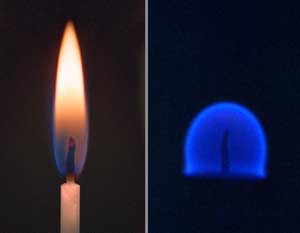Typically, the combustion process produces carbon dioxide (CO2) and water vapor, both of which are substances that cannot sustain a fire. These substances envelop the flames,
 |
|
Flame in a normal gravitational environment |
preventing it from coming into contact with the air. So, shouldn’t the flame extinguish as soon as it begins to form?
But why doesn’t that happen? Why does the combustion process continue even when the fuel reserves have not been completely burned? The only reason is that the gas expands when heated and becomes lighter. Therefore, the hot products of combustion do not remain where they were formed (in the immediate vicinity of the flames), but are quickly pushed upwards by cooler, denser air.
Here, if Archimedes’ principle does not apply to gases (or if there is no gravity), then any flame would only burn for a moment before extinguishing itself. In a low-gravity environment, flames would take on very peculiar shapes.
We can easily see the detrimental effects of combustion products on flames. You often inadvertently use it to extinguish the flame in a lamp. How do you usually blow out a kerosene lamp? You blow from above downwards, which pushes downwards towards the flame the non-combustible products (produced by combustion), and the flame goes out due to insufficient air supply.


















































